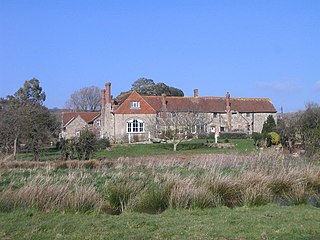
Acklam is an area in the Borough of Middlesbrough, North Yorkshire, England. It is believed that the settlement is Anglo-Saxon in origin, the name is Old English for "place at the oak clearings" or "place of oaks".

Dibden is a small village in Hampshire, England, which dates from the Middle Ages. It is dominated by the nearby settlements of Hythe and Dibden Purlieu. It is in the civil parish of Hythe and Dibden. It lies on the eastern edge of the New Forest in a valley, which runs into Southampton Water.

Denchworth is a village and civil parish about 2.5 miles (4 km) north of Wantage. It was part of Berkshire until the 1974 boundary changes transferred the Vale of White Horse to Oxfordshire. The 2011 Census recorded the parish's population as 171. The parish is bounded by the Land Brook in the west and the Childrey Brook in the east. The Great Western Main Line between Reading and Swindon runs through the parish just south of the village, but there is no station.

Snoddington is a small hamlet in Hampshire and close to the border of Wiltshire near to Thruxton Aerodrome and first mentioned in the eleventh century in the Domesday Book.

Haseley Manor is a 14th-century, Grade 2* listed property located in Arreton on the Isle of Wight.

Dippenhall is a rural hamlet in the civil parish of Crondall in the Waverley district of Surrey, England. Its post town and other administrative grouping is with Farnham, which lies approximately 1.6 miles (2.6 km) east from the village.

The Great Budbridge Manor is a manor house just south of Merstone, near Arreton, Isle of Wight, England. Fish ponds on the grounds appear medieval.

Nunwell House, also Nunwell Manor, is a historic English country house in Brading, Isle of Wight. Located 3 miles (4.8 km) south of Ryde, the Tudor and Jacobean style house also has later additions. The house contains family militaria. It was occupied by the Oglander family from Norman times until 1980. Nunwell House is a Grade II* listed building.
Branston Manor is a manor house on the Isle of Wight, situated within the Newchurch parish.
Smallbrook Manor is a manor house on the Isle of Wight, lying at the north-eastern boundary of Newchurch parish. It doubtless took its name from the stream that here forms the boundary of the parish. It is of ancient origin, as in 1280 William de Smallbrook (Smalebrook) granted land to his son Hugh. It was held at the end of the 14th century by the Wyvill family, and remained in their possession until 1491–2, when Stephen Wyvill, the last of the family, sold it to Henry Howles. Smallbrook passed in the Howles family until the reign of Elizabeth, when it was divided between co-heirs and sold to Sir William Oglander. In the court held at Ashey Manor, 1 November 1624, Sir John Oglander was returned as a freeholder and free suitor of the manor for his farm called 'Smallbroke.' The estate has since descended with Nunwell and as of 1912 was held by Mr J. H. Oglander, who had the Court Rolls in his possession.
Merston Manor is a manor house in Merstone on the Isle of Wight, England. The manor was first mentioned in the Domesday Book. Prior to the Norman Conquest, Merston Manor was owned by the Brictuin family. The present home, built in 1605 in the Jacobean style by Edward Cheeke, was rebuilt in the Victorian era. This structure may be the oldest brick house on the Island. The manor now belongs to the Crofts family.
Briddlesford Manor, is a manor house on the Isle of Wight, situated in the parish of Arreton.
Horringford Manor is a manor house on the Isle of Wight, situated in the parish of Arreton.
Rookley Manor is a manor house on the Isle of Wight, situated in the parish of Arreton. Though originally in Godshill parish, it is now included for the greater part in the boundaries of South Arreton.
Alverstone Manor is a manor house in Alverstone in the parish of Brading on the Isle of Wight.
Barnsley Manor is a manor house in the parish of Brading on the Isle of Wight.
Hardingshute Manor is a manor house in the parish of Brading on the Isle of Wight.
Rowborough Manor is a manor house in the parish of Brading on the Isle of Wight.
Sandown Manor is a manor house in the parish of Brading on the Isle of Wight.
Alspath is first recorded in the 1086 Domesday Book and was the ancient name of the original settlement in what is known today as the parish of Meriden, West Midlands situated between Birmingham and Coventry. The name means "Aelles path across the heath".








